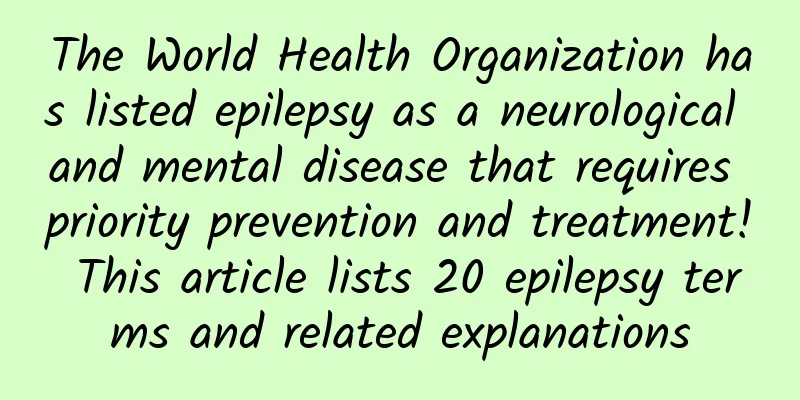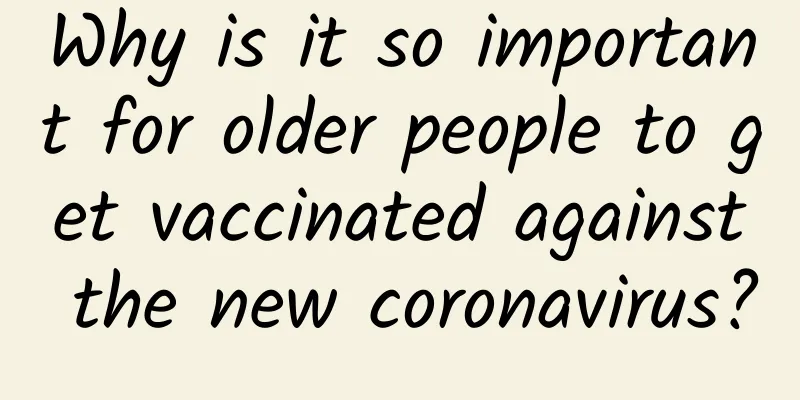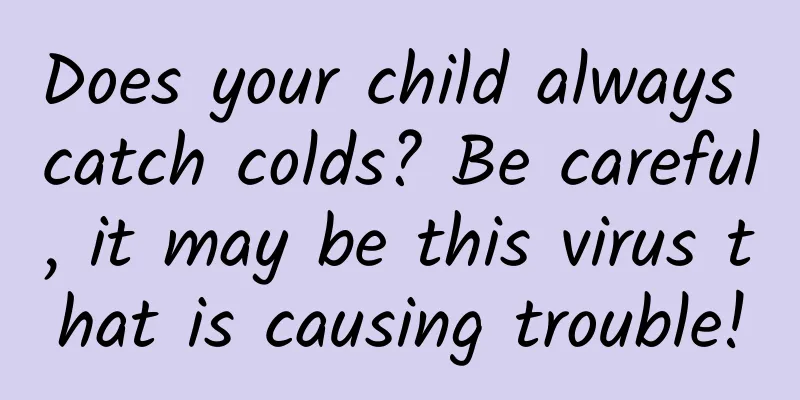The World Health Organization has listed epilepsy as a neurological and mental disease that requires priority prevention and treatment! This article lists 20 epilepsy terms and related explanations

|
The 16th "International Epilepsy Awareness Day" has a theme of "Improving Compliance, Not Just Me But You". At the 2nd "Beijing International Epilepsy Forum" in 2006, the China Anti-Epilepsy Association launched the initiative to establish "International Epilepsy Awareness Day", which received enthusiastic responses from representatives of more than 20 countries and the support of the International League Against Epilepsy. Epilepsy is a brain disease characterized by a persistent tendency to have seizures. Epilepsy patients often experience spontaneous seizures without warning, which can have serious negative impacts on individuals, families, and society. The World Health Organization has listed epilepsy as a neurological and mental disease that requires priority prevention and treatment. Epilepsy is increasingly becoming a public health and social issue that has received much attention. This article will review 20 epilepsy terms and related explanations in order to help with clinical diagnosis and treatment. 1. What causes epileptic seizures? Seizures are caused by disruptions in nerve cell pathways in the brain. Nerve cell pathways are created in the brain and are the pathways by which electrical impulses are sent and received. Most seizures are caused by epilepsy, a brain disorder that causes intermittent episodes of abnormal electrical activity. Some people are born with epilepsy, but epilepsy can also develop after any type of brain injury, such as a brain infection, stroke, brain tumor, head injury, or trauma. Seizures may also occur after alcohol withdrawal, hypoglycemia or other metabolic disturbances, or be triggered by certain medications (such as certain pain relievers, antidepressants, or smoking cessation therapies) that lower the threshold for seizures. These situations are called induced seizures, and they usually do not recur once the cause is corrected. There are also symptoms that are similar to epileptic seizures, but they are not epileptic seizures, including fainting, muscle disorders, etc. These symptoms are called nonepileptic seizures. II. Inventory of 20 epilepsy-related terms 1. Absence seizures Also known as a "petit mal seizure," it refers to an epileptic seizure that causes a brief loss of consciousness. During an absence seizure, the patient usually experiences a sudden loss of consciousness, which usually lasts for a short time. The patient often becomes suddenly still, with eyes staring and absent-minded, and usually does not experience symptoms such as falling or convulsions. The seizure lasts no more than 1 minute, stops quickly, and the patient quickly regains consciousness. 2. Atonic seizures A seizure that causes a sudden loss of muscle tone, usually in the arms and legs, and often causes the person to fall. 3. Grand mal seizure It is a common type of epileptic seizure, characterized by loss of consciousness and systemic convulsions, which may be accompanied by symptoms such as apnea, cyanosis, mydriasis, and loss of light response. It is divided into the prodromal stage, tonic stage, clonic stage, and post-convulsive stage. 4. Partial motor seizures A seizure that occurs in a limited area of one hemisphere of the brain. This type of seizure is more amenable to surgery than a generalized seizure. 5. Premonition Refers to the warning or initial symptoms that signal the beginning of a seizure. Auras may progress to focal or even generalized seizures, or they may exist on their own. 6. Epileptogenic zone An area of abnormal electrical signals in the brain that causes seizures. 7. Status epilepticus Seizure duration ≥ 30 min or no recovery between seizures. 8. Reflex epilepsy Reflex epilepsy is a seizure precipitated by a specific trigger (either through visual, auditory, somatosensory, or motor stimulation, or through higher cortical activity). 9. Drug-resistant epilepsy Refers to the adequate and appropriate use of two anti-epileptic drugs, but the failure to achieve sustained freedom from epileptic seizures. 10. Temporal neocortical epilepsy It refers to epilepsy originating from the lateral temporal lobe. The characteristics of the seizures include auditory hallucinations, illusions, dream-like states, visual symptoms, etc. When the lesion is in the dominant hemisphere, language disorders may occur. When the seizures are transmitted to the medial temporal lobe, complex partial seizures may occur. 11. Juvenile Myoclonic Epilepsy It refers to a group of epilepsy syndromes that begin in adolescence, characterized by bilateral, single or repeated, arrhythmic, irregular myoclonic startle that often involves the upper limbs, and most cases are accompanied by generalized tonic-clonic seizures and absence seizures. 12. Post-traumatic epilepsy Refers to epileptic seizures caused by head trauma, which are divided into early epilepsy and late epilepsy. Early epilepsy occurs 1 to 2 weeks after the trauma and is an acute symptomatic epilepsy. Late epilepsy occurs after the acute damage of the trauma has recovered, and the latency time from the trauma to the onset of epileptic seizures can be as long as several years. 13. Photosensitive epilepsy A type of epilepsy characterized by photic induction. The EEG shows photosensitivity, i.e., photoparoxysmal responses to intermittent flashes of light. Some recognized idiopathic generalized epilepsy syndromes, such as juvenile myoclonic epilepsy, have elevated clinical and EEG photosensitivity. 14. Epileptic personality Refers to the personality changes that occur in some epilepsy patients, manifested as sluggish thinking, narrow attention span, decreased libido, emotional instability, and violent behavior. 15. Relieve epilepsy It refers to a situation where the patient has exceeded the age of onset of a certain age-dependent epilepsy syndrome, has not had an epileptic seizure in the past 10 years, and has not used anti-epileptic drugs in the past 5 years. 16. Sudden Death Due to Epilepsy It refers to the sudden death of a patient with no other diseases except epilepsy within 1 hour (within 24 hours as recommended by the World Health Organization) after an epileptic seizure, and no cause of death other than epilepsy is found through toxicological investigation and autopsy. 17. Anticonvulsants An anti-epileptic drug used to control convulsive and non-convulsive seizures. 18. Corpus callosotomy A procedure that removes the corpus callosum and blocks the spread of seizures from one hemisphere of the brain to the other. The surgery may include the entire corpus callosum, or it may involve only part of the corpus callosum. Although seizures do not usually stop completely after surgery, they usually stop. 19. Video EEG Continuous recording of brain waves and video observation of the behavior accompanying the EEG. This technique is often performed in comprehensive epilepsy centers to diagnose epilepsy and locate the focus of seizures, which helps to develop treatment plans. 20. Ketogenic Diet A treatment for epilepsy that aims to maintain hunger or fasting metabolism for long periods of time to produce ketosis, a byproduct of fat-burning metabolism. Seizures are often reduced or eliminated during fasting periods. This diet is very high in fat and very low in carbohydrates and is often recommended for children aged 2 to 12 years. Text and layout by Yang Yining |
>>: The shingles vaccine has become a hot topic. Is it necessary for everyone to get it?
Recommend
Is it easy to get pregnant with less menstrual flow?
Many female friends experience light menstrual fl...
Does chocolate have the effect of reducing milk production?
Chocolate is a food we like very much. Many peopl...
I don't want to eat during pregnancy. Will I have a boy or a girl?
Influenced by the concept of reproduction, many a...
Is it normal to have more vaginal discharge during menopause?
Women are prone to menopause between the ages of ...
Why can't I get pregnant during ovulation?
Under normal circumstances, having sex during ovu...
There are bumps on the vulva and anus
The area between the anus and the private parts i...
Will bad stomach delay menstruation?
In life, many people have poor gastrointestinal c...
How many days does it take from intercourse to pregnancy
My female compatriots all want to increase the pr...
How to scientifically take care of the baby after cesarean section_How many days of confinement after cesarean section
Due to various reasons, many pregnant women are u...
What are the common foods for women to enlarge their breasts?
Breast enhancement has always been a topic of con...
How to calculate when is a woman’s safe period?
There are many young couples who may have just go...
Can soy milk and pumpkin be eaten together? What is the difference between green pumpkin and orange pumpkin?
Green-skinned pumpkins are rich in carbohydrates,...
Why do I suddenly have two periods in one month?
Most people know that women have menstruation onc...
What is the cause of vulvar leukoplakia?
Many women must encounter gynecological diseases ...
Is it OK to drink coffee during menstruation?
Menstruation is a special period for women, and t...









